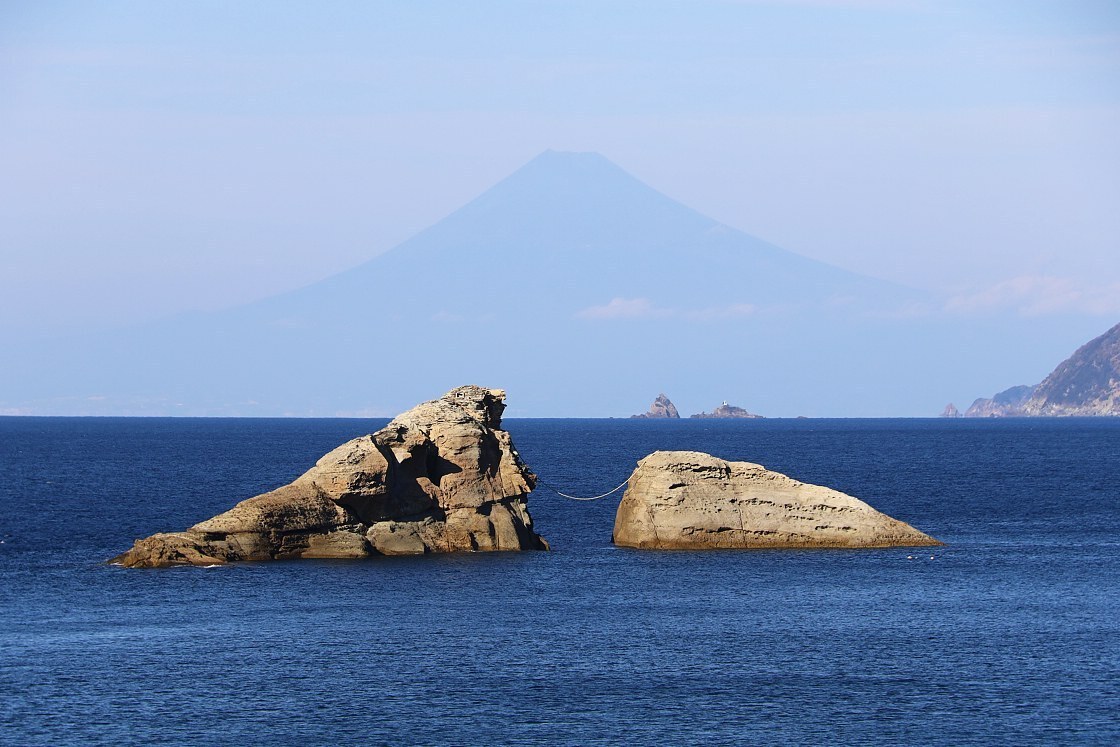Discovering Shizuoka (part two): Izu Peninsula
A beautiful area of land extending from Shizuoka Prefecture into the Pacific, the Izu Peninsula is a perfect choice for travellers looking for peace and relaxation.
Following on from my two-day trip crossing the northeastern part of Shizuoka, I made my way along the east coast of the Izu Peninsula to its southern tip, on the way discovering peaceful towns, rolling hills, soothing hot springs and some of Japan's most spectacular coastal scenery.
Day 1
My journey began towards the northeastern limit of the peninsula in Atami - a popular seaside resort town easily accessed on the Tokaido Shinkansen. From the station, I made my way uphill along a steep winding road to my first stop of the day at the MOA Museum of Art.
Perched at the top of a high slope with views over the city and out to the Sagami Bay, the museum is an attractive modern building with an impressive collection of Japanese and East Asian art. Most of the works on display are traditional in nature, ranging from painted screens and wall hangings to Buddhist sculpture and manuscripts, all elegantly presented in spacious and well-lit galleries.






Outside of the main building, the museum's grounds include a pleasant traditional garden, alongside two tea houses and a detailed reconstruction of a machiya house owned by the Edo Period screen painter Ogata Korin.


Retracing my steps to Atami Station, I took a 25 minute train ride on the Izu Kyuko Line to Ito, another seaside hot spring resort town with a number of well-preserved historic buildings clustered at its center along the Ito-Okawa River.
Built by master carpenters in 1928, the Tokaikan is one Japan's few remaining wooden hot spring ryokan from the early Showa Period. Although no longer taking guests, the ryokan remains open to visitors as a sightseeing spot and is especially worth seeing for anyone with an interest in traditional craft or architecture.

Spread across three stories with an additional observation level, it contains a series of finely crafted tatami rooms, some containing historical artifacts or exhibits about the Tokaikan and surrounding area.




From Ito, I took the Izu Kyuko Line down the coast to Shimoda Station, and there jumped on a local bus to Yumigahama, a stretch of sandy beach by the mouth of the Aono River. Skirting the coastline to the east, I soon came to a second, stony beach called Ounohama marked by a strange, clawlike rock formation known as the Ebiiwa or "Shrimp Rock".
From here, I followed a pleasant walking trail up a series of steps and into the woods, emerging about thirty minutes later at the tip of Cape Tarai to sweeping views of the windswept coast, dotted with tall crags of volcanic rock.



Continuing on the path, I caught just a few more glimpses of the coast before turning away and back into the woods. Anxious not to miss the last bus of the day at 16:07, I hurried along until I arrived at the tiny beach town of Toji.

Arriving at Izukyu Shimoda Station, I took a twenty minute ride back up the coast on the Izu Kyuko Line to Izu Inatori Station in the little seaport town of Higashiizu, where my accommodation for the night, the Inatori Ginsuiso, is located right on the seafront.
After checking in, I was keen to try the natural hot springs and was delighted to discover a spacious outdoor bath shaded by pine and palm trees. It was especially relaxing to sit and enjoy the water here in the open air, listening to the tide just a few meters away.
After a relaxing soak, I made my way to the sixth floor dining restaurant for my evening meal, and was greeted with an impressive spread of colorful appetizers, creamy sesame tofu, fresh sashimi and steamed abalone.

Already starting to feel full, I was amazed when a main course of kinmedai (splendid alfonso) arrived, beautifully cooked in a rich, dark sauce.


Day 2
Making an early start the next morning, I took a shuttle bus to the station and made my way south again to Shimoda, this time to explore some of the many historical sites within the city itself.

The southernmost city on the Izu Peninsula, Shimoda was the scene of a pivotal moment in Japan's history with the arrival of Commodore Perry's American warships in 1854. For visitors interested in delving into this topic, a great place to start is Ryosenji, an attractive Nichiren Buddhist Temple where the Japan-US Shimoda Treaty was signed.

Within the grounds of the temple stands the Black Ships Museum, where a large collection of materials relating to Perry's arrival and its cultural impact on Japan have been brought together.

From Ryosenji, I made my way southeast along Perry Road, a pleasant canal-side thoroughfare lined with willow trees and some attractive old buildings.

Following the canal to a picturesque harbor at the mouth of the Inozawa River, I arrived at the Monument for the arrival of Commodore Perry - a bust of the commodore himself flanked by an impressive iron anchor and a plaque bearing a message of friendship from President George W. Bush.


Turning south, I took a stroll through Shimoda Park, a pleasant wooded hill with some great views of the city, harbor and surrounding mountains. Within the park, a few clay outlines are all that remains of a fortress belonging to the powerful Hojo Clan, who conquered large swathes of the Kanto Region during the Period of Warring States before their eventual defeat at the hands of Toyotomi Hideyoshi.

Retracing my steps to the station, I took a long bus ride up and across to the far side of the peninsula, making one quick change at Matsuzaki. Just a few minutes after my second bus made its way out of the historic town, the road met with the Suruga Coast and a spectacular view opened up, with Mount Fuji towering in the distance.


Arriving at the tiny hot spring town of Kumomi, I followed the road back for a few minutes until I reached the foot of Mount Eboshi, a steep triangular peak of a little over 160 meters. At the end of two very long and steep flights of stone steps, I found myself at the very top beside a simple wooden shrine and a breathtaking view of ocean and rolling hills.

Although one of many Sengen Shrines, which are usually dedicated to the goddess of Mount Fuji, the Kumomi Sengen Shrine is one of just a handful of these found only on the Izu Peninsula that instead honors her older sister, Iwanagahime, the goddess of rocks. According to myth, the pair were offered by their father as brides for the god Ninigi, but due to her craggy features Iwanagahime was sent home, humiliated and embittered. To this day, local tradition has it that anyone praising the view of Mount Fuji from the summit of Mount Eboshi will meet with calamity.



After carefully descending from the rocky peak, I made my way back to the little town and took another bus north to my final stop at Dogashima, an especially scenic stretch of coast known for its dramatic cliffs and stone formations. From the Dogashima Marine, I followed a short walking route around a wooded park, offering a series of beautiful views of the surrounding bay.




A short walk south from the park, I enjoyed one last hot spring dip at the Sawada Park Open Air Bath, a simple but very pleasant cliffside bath overlooking the ocean.


With the sky darkening, I hurried back along the coast to Sehama Beach, arriving just in time for one last beautiful view of the sun setting over Sanshirojima, a cluster of four islands just 200 meters from the mainland.


